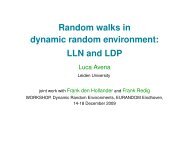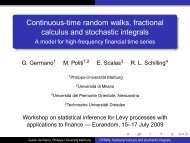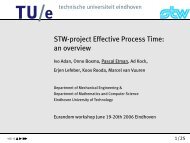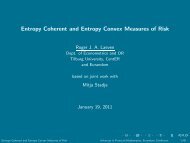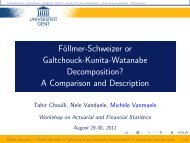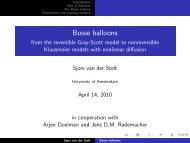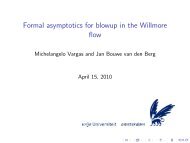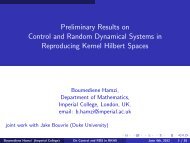EURANDOM
EURANDOM
EURANDOM
Create successful ePaper yourself
Turn your PDF publications into a flip-book with our unique Google optimized e-Paper software.
Together with Onno Boxma and Brian Fralix, we looked at the waiting times in polling systems with<br />
various service disciplines and we obtained some results in the form of Laplace-Stieltjes transforms.<br />
Cağdas Büyükkaramikli<br />
Together with Ivo Adan, Cağdas Büyükkaramikli has been investigating the distribution and the moments<br />
of the sojourn time of a queue, which starts serving at a higher rate after a certain number of<br />
customers are accumulated in the system. They also try to extend their results when the update of the<br />
capacity (i.e. server rate) increase can be only achieved at certain points where the times between two<br />
consecutive points are exponentially distributed. Together with Bernardo D'Auria (Universidad Carlos<br />
III de Madrid), they will work on further expansions of this model (i.e. when the time between two<br />
points is Erlang distributed).<br />
Jevgenijs Ivanovs<br />
My research mostly concerns fluctuations of Markov additive processes (MAP). This year we (Bernardo<br />
D'Auria, Offer Kella and Michel Mandjes) submitted two papers on this topic, where the first passage<br />
process of a spectrally-negative MAP is fully characterized.<br />
Together with Z. Palmowski we have been investigating the first passage of a reflected MAP.<br />
Michiel Jansen<br />
The coordination of material flows in a multi-item, multi-echelon supply chain network is a difficult<br />
problem. It becomes even more difficult if the transforming entities in the network (that we call production<br />
units) exhibit complex behavior dependent on capacities, and the level and composition of the<br />
workload. A hierarchical approach of the problem is inevitable. The anticipation function (cf. Schneeweiss)<br />
has an important role in hierarchical decision making. It is the description of a base level behavior<br />
at the top level. In my research, I am studying the production unit (base level) anticipation function<br />
for centralized supply chain operations planning (top level).<br />
Kamil Kosinski<br />
Together with Onno Boxma, Jevgenijs Ivanovs and Michel Mandjes we have been working on the Lévydriven<br />
polling models. We have been able to identify a branching structure in such models, which allowed<br />
us to obtain the steady-state workload distribution at polling instants and arbitrary instants in a<br />
cycle. Furthermore, he has been working with Krzysztof Debicki, Michel Mandjes and Tomasz Rolski on<br />
the asymptotics of the probability of simultaneous high extrema of an arbitrary number of Gaussian<br />
processes. We have already been able to generalize and extend some known results for the 2dimensional<br />
case. Finally, in September 2009, Kosinski started working with Onno Boxma on the heavytraffic<br />
analysis for Lévy-driven queues. This work should extend the results known for the M/G/1 queue.<br />
Andreas Löpker<br />
I'm interested in Markov Process, in particular in Piecewise Deterministic Markov Processes. I study the<br />
stability of these processes, hitting times, distributional properties and questions that have relevance<br />
to applied models.<br />
Further I study on questions regarding the modelling of the TCP window size process by PDMPs (with<br />
Johan van Leeuwaarden). Currently a new project has been planned together with David Goldberg<br />
and Teunis Ott regarding a discussion of the unstable cases for the process discussed in "TCP and Isostationary<br />
transformations".<br />
Liqiang Liu<br />
In the FALCON project I focus on using queueing network models to evaluate performance of conceptual<br />
design of picking systems. The compact picking system (CPS) is taken as a study case. A seemly paradigm<br />
adopted by Vanderlande is to place the conveyor system in the spot light. Then choices of type<br />
and number of pick stations and miniloads are made to generate suitable traffics on the conveyor for<br />
it to run on the “sweet spot”: enough to achieve desired throughput; not too much to induce excessive<br />
congestion. Of course it is desirable that the capacity of every component is fully utilized. On the other<br />
hand, it is reasonable to reserve “safety margins” due to the stochastic nature of the operations. Based<br />
on these considerations, we aim at developing fast screening tools for a large number of possible configurations.<br />
A simplified queueing network model for CPS has been proposed previously. The model involves complicating<br />
features (namely multi-class, greedy bulk service rule) in contrast to the conversional “easy-toanalyze”<br />
model. For efficient (possibly approximate) evaluation of the network, a plausible strategy is<br />
<strong>EURANDOM</strong> Annual Report 2009 9



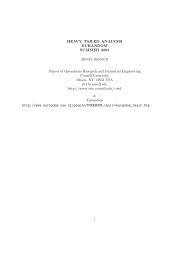
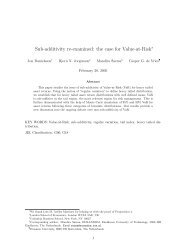
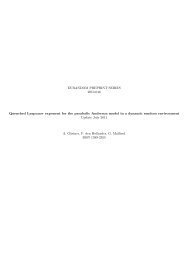
![The Contraction Method on C([0,1]) and Donsker's ... - Eurandom](https://img.yumpu.com/19554492/1/190x143/the-contraction-method-on-c01-and-donskers-eurandom.jpg?quality=85)
